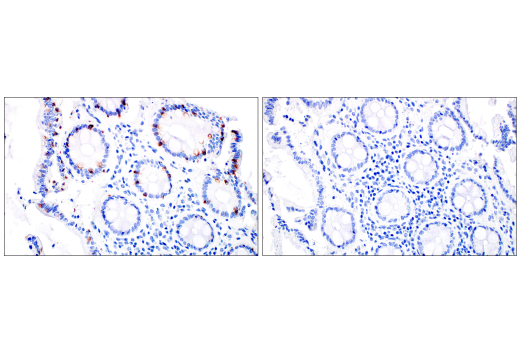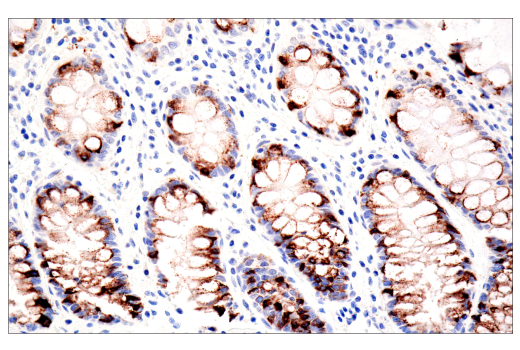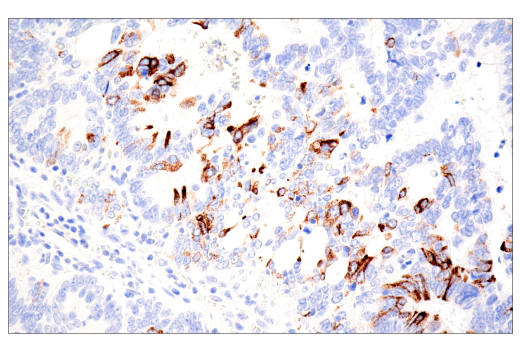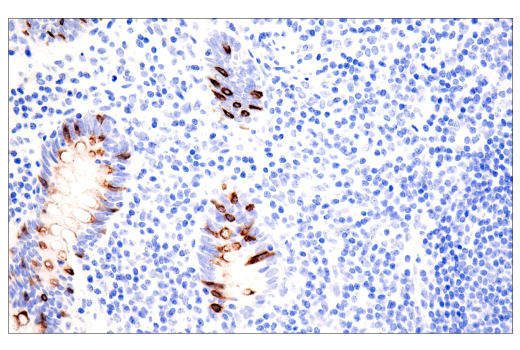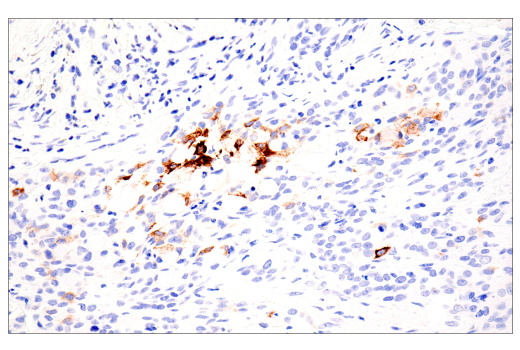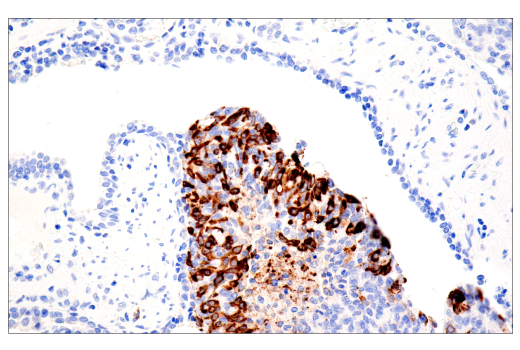IHC-P
H
Endogenous
>250
Mouse IgG1 kappa
#Q02817
4583
Product Information
Product Usage Information
| Application | Dilution |
|---|---|
| Immunohistochemistry (Paraffin) | 1:800 - 1:3200 |
Storage
Specificity / Sensitivity
Species Reactivity:
Human
Source / Purification
Monoclonal antibody is produced by immunizing animals with a synthetic peptide from human MUC2 protein, coupled to KLH.
Background
Mucins are a family of large glycoproteins that create the structural component of mucus. Mucus functions as a blockade against pathogenic invasion and physical injury to the respiratory, gastrointestinal, and urogenital tracts (1). Mucins create a protective layer for epithelial cells as either membrane-bound (MUC1, MUC3, MUC16, and MUC17) or secreted (MUC2, MUC5AC, and MUC19) proteins. MUC2, or mucin-2, the main O-glycosylated protein found in mucus, is secreted by goblet cells (2). The structure of MUC2 contains cysteine-rich N- and C-terminal domains along with a protein core made up of heavily O-glycosylated mucin domains. The high levels of O-glycosylation along with disulfide bonding make MUC2 resistant to proteolytic cleavage (3). Mucin expression and glycan structure changes occur in cancers of the intestine and impact the development and progression of these cancers (4). The presence of MUC2 in the mucous layer of the colon helps prevent ulcerative colitis (UC) by inhibiting the invasion of bacteria (5).
Species Reactivity
Species reactivity is determined by testing in at least one approved application (e.g., western blot).
Applications Key
IHC-P: Immunohistochemistry (Paraffin)
Cross-Reactivity Key
H: human M: mouse R: rat Hm: hamster Mk: monkey Vir: virus Mi: mink C: chicken Dm: D. melanogaster X: Xenopus Z: zebrafish B: bovine Dg: dog Pg: pig Sc: S. cerevisiae Ce: C. elegans Hr: horse GP: Guinea Pig Rab: rabbit All: all species expected
Trademarks and Patents
Limited Uses
Except as otherwise expressly agreed in a writing signed by a legally authorized representative of CST, the following terms apply to Products provided by CST, its affiliates or its distributors. Any Customer's terms and conditions that are in addition to, or different from, those contained herein, unless separately accepted in writing by a legally authorized representative of CST, are rejected and are of no force or effect.
Products are labeled with For Research Use Only or a similar labeling statement and have not been approved, cleared, or licensed by the FDA or other regulatory foreign or domestic entity, for any purpose. Customer shall not use any Product for any diagnostic or therapeutic purpose, or otherwise in any manner that conflicts with its labeling statement. Products sold or licensed by CST are provided for Customer as the end-user and solely for research and development uses. Any use of Product for diagnostic, prophylactic or therapeutic purposes, or any purchase of Product for resale (alone or as a component) or other commercial purpose, requires a separate license from CST. Customer shall (a) not sell, license, loan, donate or otherwise transfer or make available any Product to any third party, whether alone or in combination with other materials, or use the Products to manufacture any commercial products, (b) not copy, modify, reverse engineer, decompile, disassemble or otherwise attempt to discover the underlying structure or technology of the Products, or use the Products for the purpose of developing any products or services that would compete with CST products or services, (c) not alter or remove from the Products any trademarks, trade names, logos, patent or copyright notices or markings, (d) use the Products solely in accordance with CST Product Terms of Sale and any applicable documentation, and (e) comply with any license, terms of service or similar agreement with respect to any third party products or services used by Customer in connection with the Products.
